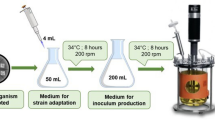Abstract
Traditional mycelium aging technology was improved to enhance arachidonic acid (ARA) production by Mortierella alpina ME-1. Filtration step was skipped and additional carbon and nitrogen sources were fed during aging. The levels of the significant factors (time, temperature, ethanol, and KNO3) affecting ARA production during improved aging process were also optimized by applying response surface methodology (RSM), and the maximum ARA yield of 19.02 g/l was achieved in a 5 l fermentor at 5.6 days, temperature 13.7 °C, ethanol 42.44 g/l, and KNO3 2.62 g/l. This yield was 1.55 times higher than that of traditional aging technology. The improved mycelium aging technology is considered to be a useful strategy for enhancing ARA production.


Similar content being viewed by others
References
Gill I, Valivety R (1997) Polyunsaturated fatty acid, part 1: occurrence, biological activities and applications. Trends Biotechnol 15:401–409
Horrobin DF, Huang YS (1987) The role of linoleic acid and its metabolites in the lowering of plasmacholesterol and the prevention of cardiovascular disease. Int J Cardiol 17:173–180
Eroshin VK, Satroutdinov AD, Dedyukhina EG, Chistyakova TI (2000) Arachidonic acid production by Mortierella alpina with growth-coupled lipid synthesis. Process Biochem 35:1171–1175
Sakuradani E, Hirano Y, Kamada N, Nojiri M, Ogawa J, Shimizu S (2004) Improvement of arachidonic acid production by mutants with lower n − 3 desaturation activity derived from Mortierella alpina 1S–4. App Microbiol Biotechnol 66:243–248
Totani N, Someya K, Oba K (1992) Industrial production of arachidonic acid by Mortierella. In: Kyle DJ, Ratledge C (eds) Industrial applications of single cell oils. AOCS, Illinois, pp 52–60
Higashiyama K, Yaguchi T, Akimoto K, Fujikawa S, Shimizu S (1998) Effects of mineral addition on the growth morphology of and arachidonic acid production by Mortierella alpina 1S–4. J Am Oil Chem Soc 75:1815–1819
Park EY, Koike Y, Higashiyama K, Fujikawa S, Okabe M (1999) Effect of nitrogen source on mycelial morphology and arachidonic acid production in cultures of Mortierella alpina. J Biosci Bioeng 88:61–67
Koike Y, Cai HJ, Higashiyama K, Fujikawa S, Park EY (2001) Effect of consumed carbon to nitrogen ratio on mycelial morphology and arachidonic acid production in cultures of Mortierella alpina. J Biosci Bioeng 91:382–389
Dyal SD, Narine SS (2005) Implications for the use of Mortierella fungi in the industrial production of essential fatty acids. Food Res Int 38:445–467
Bajpai P, Bajpai PK, Ward OP (1991) Effects of aging Mortierella mycelium on production of arachidonic and eicosapentaenoic acids. JAOCS 68:775–780
Wynn J P, Hamid A A, Ratledge C (1999) The role of malic enzyme in the regulation of lipid accumulation in filamentous fungi. Microbiology 145:1911–1917
Shinmen Y, Shimizu S, Akimoto K, Kawashima H, Yamada H (1989) Production of arachidonic acid by Mortierella fungi. Appl Microbiol Biotechnol 3:11–16
Jin MJ, Huang H, Zhang K, Yan J, Gao Z (2007) Metabolic flux analysis on arachidonic acid fermentation. J Chem Eng Chinese Univ 21:316–321
Chang YC, Lee CL, Pan TM (2006) Statistical optimization of medium components for the production of Antrodia cinnamomea AC0623 in submerged cultures. Appl Microbiol Biotechnol 72:654–661
Miller GL (1959) Use of dinitrosalicylic acid reagent for determination of reducing sugar. Anal Chem 31:426–428
Bligh EG, Dyer WJ (1957) A rapid method of total lipid extraction and purification. Can J Biochem Physiol 37:911–917
Metchalfe LD, Schmitz AA (1961) The rapid preparation of fatty acid esters for gas chromatographic analysis. Anal Chem 33:363–372
Hu YC, Huang H, Shi HF, Hu Y, Yan J, Chen L (2007) Catalytic dehydration of ethanol to ethylene using transition metal modified HZSM-5. Chem Bioeng 24:19–21
Sijtsma L, Anderson AJ, Ratledge C (2005). In: Cohen Z, Ratledge C (eds) Single cell oils. AOCS press, Illinois
Jin MJ, Huang H, Xiao AH, Peng C, Ren LJ, Liu X, Zhu H (2007) Enhancing arachidonic acid production by applying ethanol stress. Food Ferm Ind 33:52–54
Jones RP (1989) Biological principles for the effects of ethanol. Enzyme Microb Technol 11:130–153
Wynn JP, Hamid AA, Li YH, Ratledge C (2001) Biochemical events leading to the diversion of carbon into storage lipids in the oleaginous fungi Mucor circinelloides and Mortierella alpina. Microbiology 147:2857–2864
Zeng XB, Wang HY, He LY, Lin YC, Li ZT (2006) Medium optimization of carbon and nitrogen sources for the production of eucalyptene A and xyloketal A from Xylaria sp. 2508 using response surface methodology using response surface methodology. Process Biochem 41:293–298
Gupta N, Sahai V, Gupta R (2007) Alkaline lipase from a novel strain Burkholderia multivorans: Statistical medium optimization and production in a bioreactor. Process Biochem 42:518–526
Singh A, Ward OP (1997) Production of high yields of arachidonic acid in a fed-batch system by Mortierella alpina ATCC 32222. Appl Microbiol Biotechnol 48:1–5
Higashiyama K, Yaguchi T, Akimoto K, Fujikawa S, Shimizu S (1998) Enhancement of arachidonic acid production by Mortierella alpina. Abstracts of 88th AOCS Annual Meeting, 10–13 May. Chicago, IL, USA. pp 34
Hwang BH, Kim JW, Park CY, Park CS, Kim YS, Ryu YW (2005) High-level production of arachidonic acid by fed-batch culture of Mortierella alpina using NH4OH as a nitrogen source and pH control. Biotech Lett 27:731–735
Acknowledgments
This work was supported by grants from the National Natural Science Foundation of China (No. 20606018), the Ministry of Science and Technology of China [National Basic Research Program of China (No. 2007CB707805)], and Hi-Tech Research and Development Program of China (No. 2006AA02Z240).
Author information
Authors and Affiliations
Corresponding author
Rights and permissions
About this article
Cite this article
Jin, MJ., Huang, H., Xiao, AH. et al. Enhancing arachidonic acid production by Mortierella alpina ME-1 using improved mycelium aging technology. Bioprocess Biosyst Eng 32, 117–122 (2009). https://doi.org/10.1007/s00449-008-0229-1
Received:
Accepted:
Published:
Issue Date:
DOI: https://doi.org/10.1007/s00449-008-0229-1




